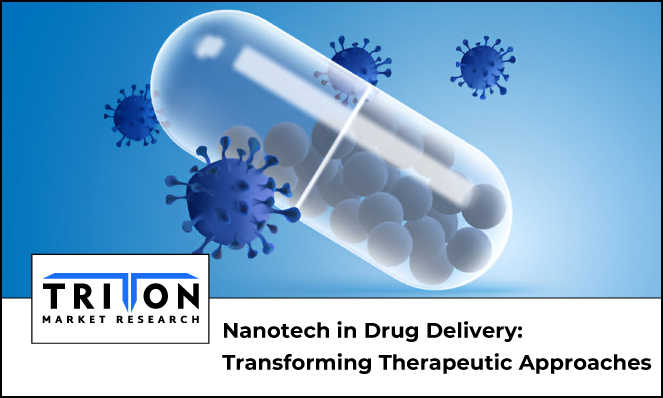



01, July 2024

The widely known methods of drug delivery include oral, parenteral (injected), topical, transdermal, nasal, ocular, etc. With current advancements in the medical field, nanotechnology is gaining significant traction in the pharmaceutical industry due to its potential application in targeted drug delivery. As nanoparticles can penetrate biological membranes to deliver medications, they are crucial in drug therapy and developing methods for early diagnosis of diseases.
Defined as particles between 1 and 100 nanometers in size, nanoparticles exhibit unique properties that make them ideal for medical applications. These properties include a high surface area-to-volume ratio and customizable surface characteristics. Nanoparticles are made from various materials, including lipids, natural and synthetic polymers, metals like gold and silver, carbon-based materials, etc.
A nanoparticle drug delivery system is a technology that uses tiny particles to deliver therapeutic agents like drugs, proteins, and genes. These nanoparticles can be engineered to specifically target diseased tissues, minimizing damage to healthy tissues. To achieve this, they are often coated with molecules that help them recognize and bind to diseased cells.
Nanoparticles can enter the human body through three main routes: direct injection, inhalation, and oral intake. The mechanism of action of nanoparticles in drug delivery primarily involves their ability to improve the bioavailability of drugs and reduce side effects.
Drugs are encapsulated or attached to nanoparticles through methods like covalent bonding, adsorption, or encapsulation in liposomes or polymeric nanoparticles. In the bloodstream, these nanoparticles bind to specific markers on target cells. Once inside the target cell, they release the drug in response to conditions like acidic pH or specific enzymes, ensuring the drug is activated directly within the cell.
From vaccines to gene therapy, nanoparticles are utilized in treating cardiovascular diseases, infectious diseases, and neurological disorders. These particles can deliver nucleic acids (DNA, RNA) to specific cells, offering potential treatments for genetic disorders and cancers.
In recent years, an increasing number of scholars have been developing nano-drug carrier systems for the diagnosis and treatment of cardiovascular diseases (CVDs). The treatment strategies of these carriers include reducing inflammation, regulating lipoprotein levels, and preventing coagulation. Such strategies are used as interventions that help in managing atherosclerosis (the most common type of CVD leading to stroke).
For the treatment of hyper tension, nano-drug carriers provide certain benefits like lowering the blood pressure effect, longer maintenance time, and manage to produce dose reduction by three times. Additionally, they also serve as delivery vehicles in vaccines, improving immune response and stability of antigens. Their application can also enhance the contrast in imaging techniques like MRI, aiding in early and precise diagnosis.
In spite of being the most preferred cancer treatment, chemotherapy drugs meet limitations such as inconsistent penetration through physiological barriers, drug resistance, and toxicity to healthy, normal cells.
In order to tackle limited cancer cell targeting and the adverse effects on normal cells, nanotechnology plays a crucial role in sorting, imaging, and characterizing immune cells while minimizing side effects. Thus, nanoparticles enhance cancer treatments by overcoming drug resistance mechanisms, improving drug accumulation in tumors, and delivering vaccines that boost T-cell responses.
Let us have a look at the case study in San Diego, where nanoparticles were developed to treat tumors.
In October 2023, engineers at the University of California created customizable modular nanoparticles for targeting tumors, viruses, and toxins. Their modularity is enabled by two synthetic proteins, SpyCatcherand SpyTag, which spontaneously bind to each other.
As a proof of concept, these nanoparticles were tested on mice with ovarian tumors, which effectively suppressed tumor growth and improved survival rates. The researchers further aim to explore the nanoparticle drug delivery system, which holds potential for vaccine development.
Another interesting application of nanotech in cancer treatments is using gold nanoparticles. Their unique properties enhance the efficacy of chemotherapy by delivering higher concentrations of the drug directly to the tumor, potentially allowing for reduced dosage and fewer associated side effects.
In this regard, the University of Texas at Dallas and UT Southwestern Medical Center published their research findings in 2023 regarding the development of a treatment method for glioblastoma, a common brain cancer. This technique used gold nanoparticles injected into the bloodstream, co-delivered with the medication.
Research on nanoparticle drug delivery systems focuses on several key areas:
Recently, researchers at the University of Sydney have developed an oral insulin based on nanotechnology. It uses a nano-carrier to deliver insulin via tablets and release it only when blood sugar levels are high.
The nanomaterial is 1/10,000th the width of a human hair, which enhances insulin absorption in the gut. Preclinical trials show effective blood glucose management without hypoglycemia or weight gain. Human trials, led by Endo Axiom Pty Ltd, are set to begin in 2025.
The advent of nanotechnology has revolutionized the healthcare sector, particularly medicine being primary beneficiaries. One of the most promising applications of nanotechnology is evident in drug delivery systems, where nanoparticles are engineered to enhance the delivery and efficacy of therapeutic agents. Thus, the exploration and latest developments in nanotechnology imply a widening scope of nanoparticles in drug delivery.

Prevalent cases of terrorist attacks in today’s world is increasing the need for severe standards of security for public safety, and the global market for biometric technology scrupulously accommoda..
Prevalent cases of terrorist attacks in today’s world is increasing the need for..